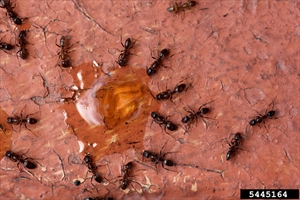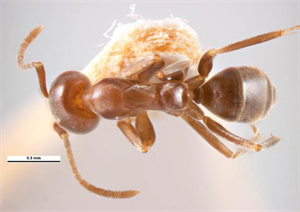- Worldwide distribution. In Australia, New Zealand, NOT Pacific island countries. Among 100 world's worse invasive species. Difficult to manage; aggressive, but does not sting, bite or spray formic acid. Favours disturbed areas, invades houses.
- Nests on ground, rarely in buildings. Forms super-colonies. Food is mainly nectar and honeydew. Other insects taken to feed queens and brood.
- Damage directly: loss of biodiversity - alters seed dispersal, pollination; indirectly by defending aphids, mealybugs, scales and whiteflies from natural enemies.
- Tramp ant. Spread by 'budding' - queens and workers leave the colony; spread via international trade.
- Biosecurity: requires risk assessments, regulations preventing introduction, protocols in case of breaches, and ability to make rapid response. Pacific Ant Prevention Plan available (IUCN/SSC Invasive Specialist Group).
- Cultural control: hot water at 47°C kills ants; over 49°C kills plants.
- Chemical control: use (i) stomach poisons (fipronil, Amdro®, borax), (ii) growth regulators (methoprene, pyriproxyfen), (iii) nerve poisons (bifenthrin, fipronil, imidacloprid). See (http://piat.org.nz/getting-rid-of-ants).








